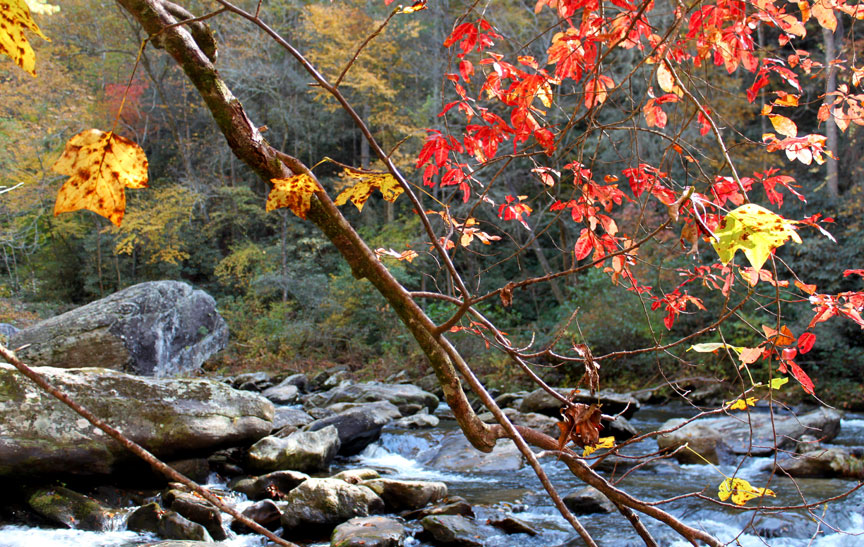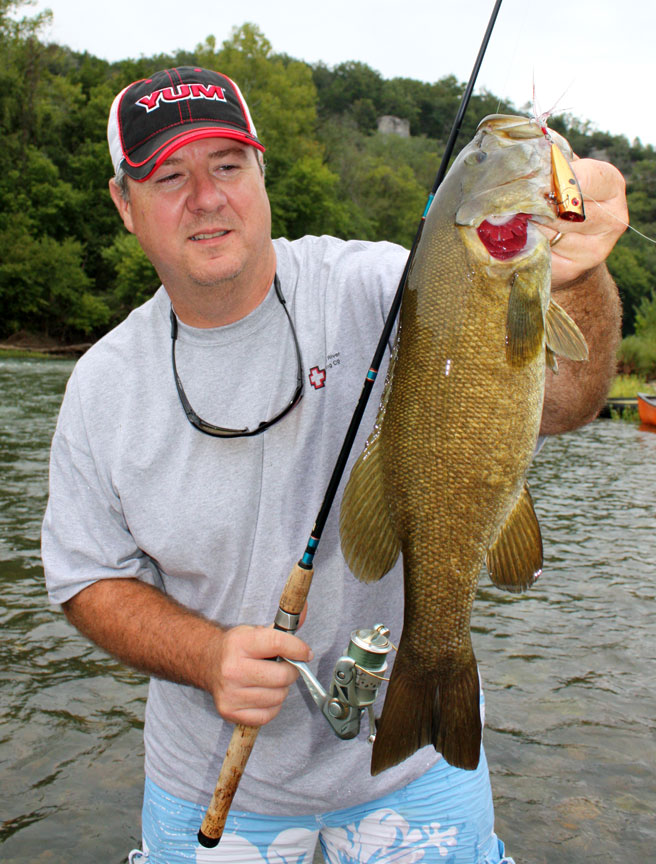 Your spouse wants to see the fall foliage. The kids need a break from schoolwork. You’ve done your part, too, singing those workingman blues. Before the craziness of the holidays, give yourself a minute to remember the glory of nature. There’s no better escape than to an Appalachian smallmouth stream. You all deserve it. Smashing surface strikes, high-jumping fish, fast action, splendid scenery — the list of things to love about stream fishing for Appalachian smallmouth bass is unending. Plus, catching fish is pretty simple. A light or medium-weight spinning outfit spooled with 6- or 8-lb test and a modest selection of lures is all you need.
Your spouse wants to see the fall foliage. The kids need a break from schoolwork. You’ve done your part, too, singing those workingman blues. Before the craziness of the holidays, give yourself a minute to remember the glory of nature. There’s no better escape than to an Appalachian smallmouth stream. You all deserve it. Smashing surface strikes, high-jumping fish, fast action, splendid scenery — the list of things to love about stream fishing for Appalachian smallmouth bass is unending. Plus, catching fish is pretty simple. A light or medium-weight spinning outfit spooled with 6- or 8-lb test and a modest selection of lures is all you need.
Options along the Appalachians include simple wading, canoeing or kayaking, and in some cases johnboats. Hiking trails abound.
For anglers, the best part is that autumn is topwater season. Topwater lures like the Heddon Tiny Torpedo and Rebel Pop-R and Teeny Pop-R are perfect. For some reason, topwaters often appeal to the biggest smallmouth in any stream, and unless they’re thrown into a bankside tree, they can be worked around rocks and cover without snagging.

Another good topwater option is a tiny buzzbait. In fact, a buzzbait may be the right lure to start with because it fishes fast, and each strike gives you a hint as to where the smallmouth are holding. Some days, smallies are in every spot that looks good. Often, though, the biggest fish will be in specific spots, at the heads of deep holes, in the strongest eddies or at the top edges of tapering gravel bars. Productive zones vary daily, so patterning is critical.
Some days the fish just won’t commit to a topwater, though, and if you want to keep the kids (or yourself) interested you’d better be ready for it. The Rebel Teeny Wee Craw is the answer. Simple cast-and-crank retrieves catch every fish in the river.
For best results, angle casts upstream and across, and simply reel fast enough to keep the lure wobbling. Across shallow shoals, keep the rod tip pointed downward and slow your retrieve to make the lure dig into the bottom. In spots with heavy current, cast directly across the stream and reel enough to get the lure under the water, then stop. The current will enact the lure’s action and it will swing along in a loop, looking like a real crawfish fighting the current.
 There are lures designed for super-strong current, and it’s a good idea to have one or two handy should surprise rains swell the flow and transform it from a gentle grandfather to a drunken uncle. The Lindy River Rocker was built for fishing in strong current. Smallmouth love the smallest size, but you’ll also catch trout, sunfish, walleyes and anything else holding in the fast water. If you decide on a canoe or kayak float, River Rockers are essential for trolling while you enjoy scenery that no artist or photograph can capture.
There are lures designed for super-strong current, and it’s a good idea to have one or two handy should surprise rains swell the flow and transform it from a gentle grandfather to a drunken uncle. The Lindy River Rocker was built for fishing in strong current. Smallmouth love the smallest size, but you’ll also catch trout, sunfish, walleyes and anything else holding in the fast water. If you decide on a canoe or kayak float, River Rockers are essential for trolling while you enjoy scenery that no artist or photograph can capture.
If you’re hiking, the most-convenient way to go is by slipping a package of hooks and a few weights into a bag of soft plastics, grabbing an ultralight rig and putting boot to dirt. A rig that outdoor writer and frequent visitor to various Appalachian rivers and streams Jeff Samsel developed is perfect. Instead of traditional straight-shanked or wide-gap hooks, he’s found that a circle hook provides more action and a better hook-up rate.
He suggests a 4-inch YUM Dinger – a straight soft-plastic stickbait – nose-hooked with no weight at all. The circle hook allows the Dinger full freedom to dart when twitched or to simply drift with the current, and is almost as weedless as a Texas-rigged lure. Plus, this kind of hook does all of the hook-set work for you – instead of whipping back a strong hook-set, simply reeling fast impales the hook.
One final note applies to fall smallmouth fishing in Appalachian streams, no matter which offering you choose: Don’t get too hung up on catching smallmouth. There are a lot more species swimming in those streams, and they’re fun to catch, too.
Where To Go
New River
Best Base Camp: Fayetteville, W.Va.
Traditional Peak of Fall Foliage: Mid October
Dine At: Smokey’s on the Gorge (1 Ames Heights Road, Lansing). Smokey’s features spectacular views and a gourmet buffet.
Opportunities extend from easily waded waters in the North Carolina Mountains to the river’s end in West Virginia nearly 300 miles downstream, however, the West Virginia portion includes the spectacular New River Gorge and 70,000 acres of public land within the corridor of the New River Gorge National River. Fishing and lodging: http://www.onthegorge.com
Little Tennessee River
Best Base Camp: Franklin, N.C.
Traditional Peak of Fall Foliage: Late October
Don’t Miss: The Franklin PumpkinFest, Oct. 26
Winding between farmland and forested mountainsides and eventually bordering the Great Smoky Mountains, the Little Tennessee River supports a great population of thick-sided smallmouths that can be accessed by floating or wading, depending on water levels and the specific location. Fishing, canoe rentals and lodging: http://www.fishcamp.biz
Pigeon River
Best Base Camp: Newport, Tenn.
Traditional Peak of Fall Foliage: Last two weeks of October
Luxury Stay: Christopher Place Resort Bed & Breakfast. Perfect romantic stay for couples, but reserve well in advance. www.christopherplace.com
Once polluted from upstream industry, the Pigeon now supports a thriving whitewater industry when the water is high from the outflow of Waterville Powerhouse and some of the best smallmouth fishing in Appalachia when the water is low. Big fish are the main attraction from the powerhouse to the river’s end.
James River
Best Base Camp: Glasgow, Va.
Traditional Peak of Fall Foliage: Last week of October
Don’t Miss: The Natural Bridge and Caverns www.naturalbridgeva.com
Spectacular scenery combines with outstanding fall fishing on the Upper James River, which rises high in the mountains of Virginia and winds through the heart of Blue Ridge country. Fishing: http://www.confluenceoutfittersva.com
Bonus Destination: Buffalo River
Best Base Camp: Jasper, Ark.
Traditional Peak of Fall Foliage: Late October/Early November
Don’t Miss: Hilary Jones Wildlife Museum and Elk Information Center. www.arkansaselkcenter.com
Although not technically part of Appalachia, the Buffalo River is one of several Ozarks streams that offer similar opportunities for outstanding fall smallmouth fishing. The Buffalo National River flows freely for 135 miles, with extensive public access. Lodging, Crawford’s Cabins, (870) 446-2478, www.buffalorivercountry.com
.
